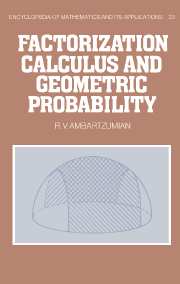
-
Select format
-
- Publisher:
- Cambridge University Press
- Publication date:
- November 2011
- September 1990
- ISBN:
- 9781139086561
- 9780521345354
- 9780521089784
- Dimensions:
- (234 x 156 mm)
- Weight & Pages:
- 0.585kg, 300 Pages
- Dimensions:
- (234 x 156 mm)
- Weight & Pages:
- 0.42kg, 300 Pages
- Subjects:
- Mathematics (general), Mathematics, Abstract Analysis
- Series:
- Encyclopedia of Mathematics and its Applications (33)
You may already have access via personal or institutional login- Subjects:
- Mathematics (general), Mathematics, Abstract Analysis
- Series:
- Encyclopedia of Mathematics and its Applications (33)
Book description
This unique book develops the classical subjects of geometric probability and integral geometry, and the more modern one of stochastic geometry, in rather a novel way to provide a unifying framework in which they can be studied. The author focuses on factorisation properties of measures and probabilities implied by the assumption of their invariance with respect to a group, in order to investigate non-trivial factors. The study of these properties is the central theme of the book. Basic facts about integral geometry and random point process theory are developed in a simple geometric way, so that the whole approach is suitable for a non-specialist audience. Even in the later chapters, where the factorisation principles are applied to geometrical processes, the prerequisites are only standard courses on probability and analysis. The main ideas presented here have application to such areas as stereology and tomography, geometrical statistics, pattern and texture analysis. This book will be well suited as a starting point for individuals working in those areas to learn about the mathematical framework. It will also prove valuable as an introduction to geometric probability theory and integral geometry based on modern ideas.
Reviews
Review of the hardback:‘The authors presented themselves with an enormous task in gathering material from widely scattered areas to illustrate a single theme. It is a measure of how well they have succeeded that everything now seems coherent and interwoven. For this they deserve our sincere thanks.’
Source: Bulletin of the London Mathematical Society
Review of the hardback:‘An opera of real analysis…’
Source: Bulletin of the American Mathematical Society
Contents
Metrics
Altmetric attention score
Full text views
Full text views help Loading metrics...
Loading metrics...
* Views captured on Cambridge Core between #date#. This data will be updated every 24 hours.
Usage data cannot currently be displayed.
Accessibility standard: Unknown
Why this information is here
This section outlines the accessibility features of this content - including support for screen readers, full keyboard navigation and high-contrast display options. This may not be relevant for you.
Accessibility Information
Accessibility compliance for the PDF of this book is currently unknown and may be updated in the future.


